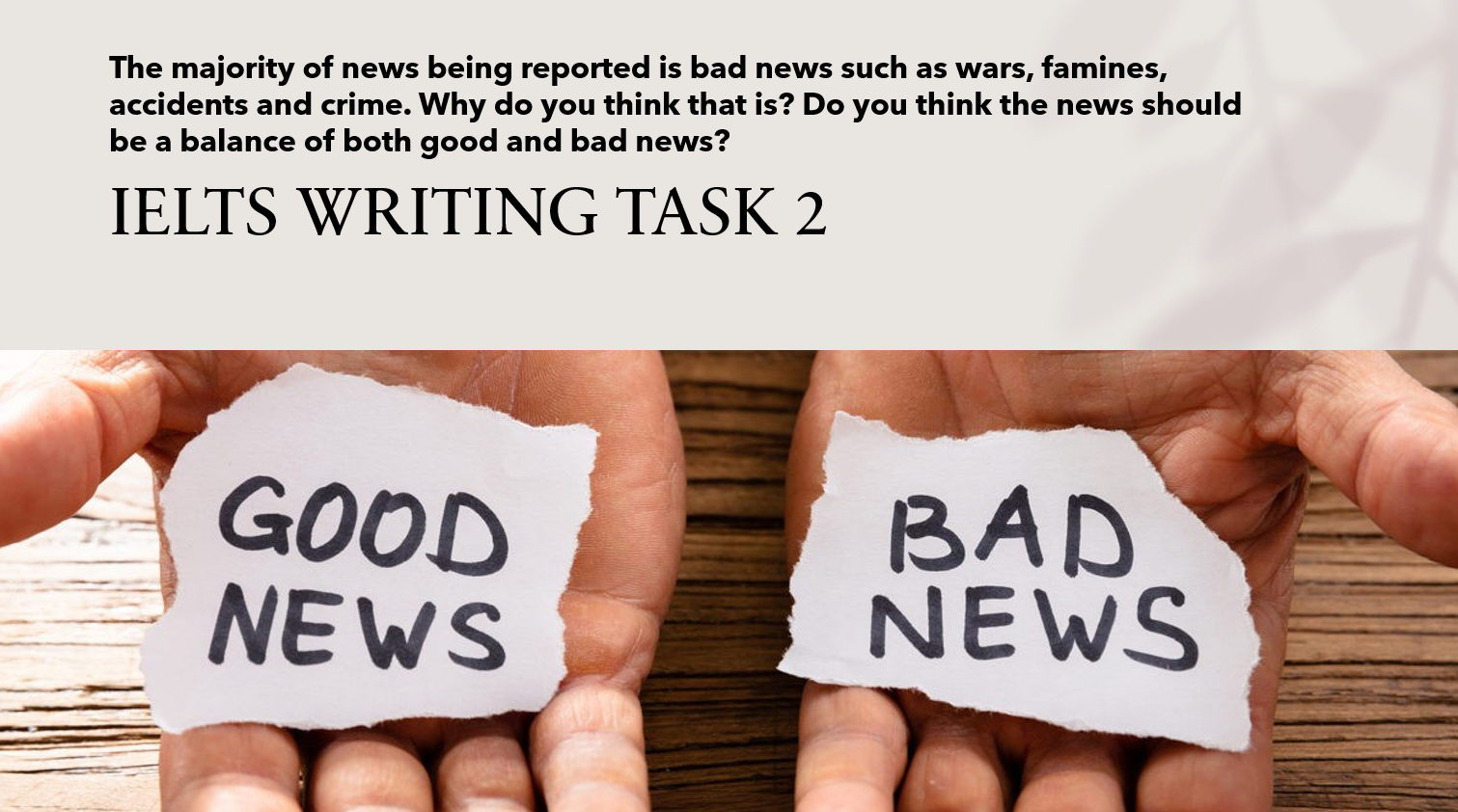Chào các bạn! Trong bài viết hôm nay, Hà English sẽ trình bày một bài mẫu IELTS Writing Task 2 về chủ đề Truyền thông/Quảng cáo. Câu hỏi của chúng ta gồm hai phần: “The majority of news being reported is bad news such as wars, famines, accidents, and crime. Why do you think that is? Do you think the news should be a balance of both good and bad news?”
Chủ đề về sự tập trung vào tin tức xấu trong truyền thông đã và đang là một vấn đề đáng quan tâm. Trong bài viết này, chúng tôi sẽ thảo luận về nguyên nhân mà tin tức thường tập trung vào tin tức xấu và sự cần thiết của sự cân bằng giữa tin tức tốt và xấu trong truyền thông.

Mục lục
Đề bài:
The majority of news being reported is bad news such as wars, famines, accidents and crime. Why do you think that is? Do you think the news should be a balance of both good and bad news?
Các bước làm bài IELTS Writing Task 2 dành cho đề bài trên
Step 1: Understand Our Task
Our task is to analyze why the majority of news reported is bad news, including wars, famines, accidents, and crime. We must also consider whether news reporting should strive for a balance between good and bad news.
Bước 1: Hiểu nhiệm vụ của chúng ta
Nhiệm vụ của chúng ta là phân tích tại sao đa số tin tức được báo cáo là tin tức xấu, bao gồm chiến tranh, nạn đói, tai nạn và tội phạm. Chúng ta cũng cần xem xét liệu việc báo cáo tin tức có nên cố gắng cân bằng giữa tin tức tốt và tin tức xấu.
Step 2: Decide Our Position
In this essay, I will argue that the prevalence of bad news in reporting is primarily due to its attention-grabbing nature, but I will also emphasize the importance of achieving a balance between good and bad news in the media.
Bước 2: Quyết định quan điểm của chúng ta
Trong bài luận này, tôi sẽ bào chữa rằng sự thịnh hành của tin tức xấu trong báo cáo chủ yếu là do tính chất thu hút sự chú ý của nó, nhưng tôi cũng sẽ nhấn mạnh sự quan trọng của việc đạt được sự cân bằng giữa tin tức tốt và tin tức xấu trong phương tiện truyền thông.
Step 3: Extend Our Answer
Reasons for the Prevalence of Bad News:
- Human Psychology: Bad news tends to grab people’s attention more effectively than good news. This is rooted in human psychology, where negative information is perceived as more urgent and relevant to our survival instincts. Media outlets understand this and often prioritize sensational and negative stories to attract viewers or readers.
- Profit Motive: Media organizations are profit-driven. They rely on advertising revenue, and bad news stories often generate higher viewership or readership, which translates to more advertising income. This financial incentive can lead to the overrepresentation of bad news.
- Globalization: In today’s interconnected world, news travels rapidly. Bad news stories, such as conflicts or disasters, have a global impact and are therefore considered more newsworthy. This globalization of news leads to the perception that bad news is more prevalent.
Importance of a Balance Between Good and Bad News:
- Balanced Perspective: A news landscape dominated by bad news can create a skewed perspective of the world. It’s essential for the public to have a balanced view of both the challenges and positive developments happening globally.
- Mental Health: Continuous exposure to negative news can have adverse effects on mental health, leading to anxiety and stress. Including good news stories can provide a respite and promote mental well-being.
- Motivation and Hope: Positive news can inspire and motivate individuals to make positive changes in their lives and communities. Stories of progress, kindness, and resilience can offer hope and drive constructive action.
Bước 3: Mở rộng quan điểm của chúng ta
Lý do vì sao tin tức xấu thường xuyên:
- Tâm lý con người: tin tức xấu thường thu hút sự chú ý của người dân hiệu quả hơn tin tức tốt. Điều này xuất phát từ tâm lý con người, nơi thông tin tiêu cực được coi là cấp thiết và liên quan đến bản năng sinh tồn của chúng ta. Các phương tiện truyền thông hiểu điều này và thường ưu tiên các câu chuyện kịch tính và tiêu cực để thu hút người xem hoặc độc giả.
- Động cơ lợi nhuận: tổ chức truyền thông đang theo đuổi mục tiêu lợi nhuận. Họ phụ thuộc vào doanh thu quảng cáo, và các câu chuyện tin tức xấu thường tạo ra lượng xem hoặc đọc cao hơn, điều này dẫn đến thu nhập quảng cáo nhiều hơn. Sự khích lệ tài chính này có thể dẫn đến việc báo cáo quá nhiều tin tức xấu.
- Toàn cầu hóa: trong thế giới liên kết ngày nay, tin tức lan truyền nhanh chóng. Các câu chuyện tin tức xấu, như xung đột hoặc thảm họa, có tác động toàn cầu và vì vậy được coi là đáng tin hơn. Sự toàn cầu hóa của tin tức dẫn đến quan điểm rằng tin tức xấu thường xuyên hơn.
Sự quan trọng của sự cân bằng giữa tin tức tốt và tin tức xấu:
- Góc nhìn cân đối: một bản cảnh tin tức bị chi phối bởi tin tức xấu có thể tạo ra góc nhìn bị méo mọi người về thế giới. Điều quan trọng là công chúng phải có cái nhìn cân bằng về cả những thách thức và sự phát triển tích cực đang diễn ra trên toàn cầu.
- Tâm lý sức khỏe: tiếp xúc liên tục với tin tức tiêu cực có thể gây ra ảnh hưởng xấu đối với tâm lý sức

Full Sample Essay
Introduction
The world of news reporting often seems inundated with a torrent of bad news, ranging from wars and famines to accidents and crime. This essay delves into the reasons behind this phenomenon and considers whether a more balanced approach, including both good and bad news, should be adopted in journalism. While the prevalence of bad news can be attributed to its attention-grabbing nature and profit motives, a balanced news landscape is crucial for a holistic understanding of the world.
Body Paragraph 1: Reasons for the Prevalence of Bad News
The predominance of bad news in media can be partially attributed to human psychology. Our minds are wired to react more strongly to negative information. Negative news often triggers our survival instincts, making it more attention-grabbing. Media outlets understand this and capitalize on it by prioritizing sensational and negative stories. Furthermore, the profit motive plays a significant role in the prevalence of bad news. Media organizations rely on advertising revenue, and bad news stories tend to attract larger audiences. This financial incentive encourages the continuous reporting of negative events. Additionally, globalization has made bad news more newsworthy. Conflicts and disasters have far-reaching consequences in our interconnected world, further contributing to their prominence in news reporting.
Body Paragraph 2: Importance of a Balance Between Good and Bad News
However, it is essential to recognize the importance of achieving a balance between good and bad news. A news landscape dominated by bad news can distort our perception of the world, creating a sense of constant crisis. To foster a more accurate understanding, both the challenges and positive developments worldwide should be represented. Furthermore, the mental health of news consumers is a significant concern. The continuous exposure to distressing news can lead to anxiety and stress. Including good news stories can provide a respite, contribute to mental well-being, and counterbalance the negative emotional impact of bad news. Positive news also has the potential to motivate and inspire individuals. Stories of progress, kindness, and resilience can instill hope and encourage people to engage in positive actions, both individually and collectively.
Conclusion
In conclusion, the preponderance of bad news in reporting is driven by its attention-grabbing nature and profit motives, but it also raises questions about the need for a balanced news landscape. Achieving such balance is essential for providing a comprehensive understanding of the world, promoting mental well-being, and inspiring positive change. While bad news may continue to dominate headlines, the inclusion of good news stories is a necessary step toward a more informed and hopeful society.
Useful Phrases/Collocations (with Vietnamese meanings):
- Attention-grabbing nature: Tính chất thu hút sự chú ý
- Profit-driven: Được thúc đẩy bởi lợi nhuận
- Global impact: Tác động toàn cầu
- Skewed perspective: Góc nhìn sai lệch
- Mental well-being: Sức khỏe tinh thần
- Adverse effects: Tác động bất lợi
- Holistic understanding: Hiểu biết toàn diện
- Distort our perception: Xuyên tạc quan điểm của chúng ta
- Counterbalance the negative impact: Cân bằng tác động tiêu cực
- Instill hope: Gieo niềm hi vọng
- Positive change: Sự thay đổi tích cực
Xem thêm các bài viết IELTS Writing Task 2 khác TẠI ĐÂY
Tổng kết
Tóm lại, chúng tôi đã thảo luận về tình hình tập trung vào tin tức xấu trong truyền thông và sự cần thiết của sự cân bằng giữa tin tức tốt và xấu. Câu hỏi này đặt ra một vấn đề quan trọng về cách truyền thông hiện thực hóa tin tức và vai trò của nó trong việc hình thành quan điểm của công chúng.
Mặc dù tin tức xấu thường được tập trung để thu hút sự chú ý, sự cân bằng giữa tin tức tốt và xấu có thể giúp khán giả có cái nhìn tổng thể và tránh trạng thái lo âu không cần thiết. Hà English hy vọng rằng bài viết này đã giúp bạn hiểu rõ hơn về chủ đề này và tầm quan trọng của sự cân bằng trong thông tin.
Nếu bạn đang tìm kiếm một trung tâm Anh ngữ uy tín và chất lượng, Hà English là một sự lựa chọn tuyệt vời. Với hơn 10 năm kinh nghiệm trong lĩnh vực giảng dạy tiếng Anh, trung tâm đã đạt được uy tín cao trong việc đào tạo học viên về ngoại ngữ.

Hà English tự hào là một môi trường học tập chuyên nghiệp và thân thiện, với đội ngũ giáo viên có trình độ cao và giàu kinh nghiệm. Những giảng viên tại trung tâm không chỉ sở hữu kiến thức chuyên môn vững vàng mà còn có khả năng tạo động lực và sự hứng thú trong quá trình học tập của học viên.
Dạy từ tâm – nâng tầm tri thức
Đăng kí tư vấn nhận lộ trình học phù hợp từ Hà English ngay!
